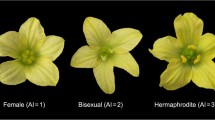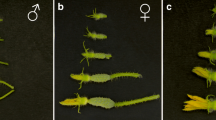Abstract
Cucumber (Cucumis sativus L.) has served as the model system for sex expression in flowering plants and its sex type is predominantly controlled by two genetic loci, F and M. Ethylene is the major plant hormone that regulates sex expression in cucumber. The current model predicts that ethylene serves as both a promoter of femaleness via the F locus and an inhibitor of the male sex via the M locus. In support of this model, genetic, genomic, and transcript analyses indicate that the F gene encodes a key enzyme in ethylene biosynthesis. In this study, we discovered that the M locus co-segregates with an ETHYLENE-INSENSITIVE3 (EIN3)-like genomic sequence in an F2 population of 96 individuals. This genetic association agrees with the prediction that the M locus is involved in ethylene signaling, thus providing another line of evidence in favor of the model. In addition, we generated an amplified fragment length polymorphism (AFLP®) map of the M locus, which was delimited into a genetic interval of 2.5 cM. The genetic association and the local map will assist the molecular isolation of the M gene using the combination of positional cloning and candidate gene approach.




Similar content being viewed by others
References
Chao Q, Rothenberg M, Solano R, Roman G, Terzaghi W, Ecker JR (1997) Activation of the ethylene gas response pathway in Arabidopsis by the nuclear protein ETHYLENE-INSENSITIVE3 and related proteins. Cell 89:1133–1144
Deng S-l, Pan J-s, He H-l, Wu A-z, R Cai (2006) SRAP molecular marker linked to M Gene in cucumber. J Shanghai Jiaotong Univer (Agric Sci) 24:240–244
Galun E (1961) Study of the inheritance of sex expression in the cucumber, the interactions of major genes with modifying genetic and non-genetic factors. Genetica 32:134–163
Guo H, Ecker JR (2004) The ethylene signaling pathway: new insights. Curr Opin Plant Biol 7:40–49
Iordachescu M, Verlinden S (2005) Transcriptional regulation of three EIN3-like genes of carnation (Dianthus caryophyllus L. cv. Improved White Sim) during flower development and upon wounding, pollination, and ethylene exposure. J Exp Bot 56:2011–2018
Kamachi S, Sekimoto H, Kondo N, Sakai S (1997) Cloning of a cDNA for a 1-aminocyclopropane-1-carbo-xylate synthase that is expressed during development of female flowers at the apices of Cucumis sativus L. Plant Cell Physiol 38:1197–1206
Kende H (1993) Ethylene biosynthesis. Annu Rev Plant Physiol Plant Mol Biol 44:283–307
Knopf RR, Trebitsh T (2006) The female-specific Cs-ACS1G gene of cucumber. A case of gene duplication and recombination between the non-sex-specific 1-aminocyclopropane-1-carboxylate synthase gene and a branched-chain amino acid transaminase gene. Plant Cell Physiol 47:1217–1228
Kosambi DD (1944) The estimation of map distance from recombination values. Ann Eugen 12:172–175
Kubicki B (1969a) Investigation of sex determination in cucumber (Cucumis sativus L.). Genet Pol 10:101–121
Kubicki B (1969b) Investigation of sex determination in cucumber (Cucumis sativus L.). Genet Pol 10:5–22
Kubicki B (1969c) Investigation of sex determination in cucumber (Cucumis sativus L.). Genet Pol 10:123–143
Kubicki B (1969d) Investigations of sex determination in cucumber (Cucumis sativus L.). Genet Pol 10:69–86
Malepszy S, Niemirowicz-Szczytt K (1991) Sex determination in cucumber (Cucumis sativus) as a model system for molecular biology. Plant Sci 80:39–47
Margulies M, Egholm M, Altman WE, Attiya S, Bader JS, Bemben LA, Berka J, Braverman MS, Chen YJ, Chen Z, Dewell SB, Du L, Fierro JM, Gomes XV, Godwin BC, He W, Helgesen S, Ho CH, Irzyk GP, Jando SC, Alenquer ML, Jarvie TP, Jirage KB, Kim JB, Knight JR, Lanza JR, Leamon JH, Lefkowitz SM, Lei M, Li J, Lohman KL, Lu H, Makhijani VB, McDade KE, McKenna MP, Myers EW, Nickerson E, Nobile JR, Plant R, Puc BP, Ronan MT, Roth GT, Sarkis GJ, Simons JF, Simpson JW, Srinivasan M, Tartaro KR, Tomasz A, Vogt KA, Volkmer GA, Wang SH, Wang Y, Weiner MP, Yu P, Begley RF, Rothberg JM (2005) Genome sequencing in microfabricated high-density picolitre reactors. Nature 437:376–380
Mibus H, Tatlioglu T (2004) Molecular characterization and isolation of the F/f gene for femaleness in cucumber (Cucumis sativus L.). Theor Appl Genet 109:1669–1676
Murray MG, Thompson WF (1980) Rapid isolation of high molecular weight plant DNA. Nucleic Acids Res 8:4321–4325
Myburg AA, Remington DL, O’ Malley DM, Sederoff RR, Whetten RW (2001) High-throughput AFLP analysis using infrared dye-labeled primers and an automated DNA sequencer. BioTechniques 30:348–357
Perl-Treves P (1999) Male to female conversion along the cucumber shoot: approaches to studying sex genes and floral development in Cucumis sativus. In: Ainsworth CC (ed) Sex determination in plants. BIOS Scientific Publisher, Oxford
Peterson CE, Staub JE, Williams PH, Palmer MJ (1986) Wisconsin 1983 cucumber. HortScience 21:1082–1083
Pierce LK, Wehner TC (1990) Review of genes and linkage groups in cucumber. HortScience 25:605–615
Rieu I, Mariani C, Weterings K (2003) Expression analysis of five tobacco EIN3 family members in relation to tissue-specific ethylene responses. J Exp Bot 54:2239–2244
Rudich J, Halevy AH, Kedar N (1972) Ethylene evolution from cucumber plants as related to sex expression. Plant Physiol 49:998–999
Shifriss O (1961) Sex control in cucumbers. J Hered 52:5–12
Stam P (1993) Construction of integrated genetic linkage maps by means of a new computer package: Join Map. Plant J 3:739–744
Stepanova AN, Alonso JM (2005) Arabidopsis ethylene signaling pathway. Sci STKE 2005:cm4
Takahashi H, Saito T, Suge H (1983) Separation of effects of photoperiod and hormones on sex expression in cucumber. Plant Cell Physiol 24:142–154
Tanurdzic M, Banks JA (2004) Sex-determining mechanisms in land plants. Plant Cell 16(Suppl):S61–S71
Tieman DM, Ciardi JA, Taylor MG, Klee HJ (2001) Members of the tomato LeEIL (EIN3-like) gene family are functionally redundant and regulate ethylene responses throughout plant development. Plant J 26:47–58
Trebitsh T, Staub JE, O’Neill SD (1997) Identification of a 1-aminocyclopropane-1-carboxylic acid synthase gene linked to the female (F) locus that enhances female sex expression in cucumber. Plant Physiol 113:987–995
Vos P, Hogers R, Bleeker M, Reijans M, van de Lee T, Hornes M, Frijters A, Pot J, Peleman J, Kuiper M et al (1995) AFLP: a new technique for DNA fingerprinting. Nucleic Acids Res 23:4407–4414
Witkowicz J, Urbanczyk-Wochniak E, Przybecki Z (2003) AFLP marker polymorphism in cucumber (Cucumis sativus L.) near isogenic lines differing in sex expression. Cell Mol Biol Lett 8:375–381
Yamasaki S, Fujii N, Matsuura S, Mizusawa H, Takahashi H (2001) The M locus and ethylene-controlled sex determination in andromonoecious cucumber plants. Plant Cell Physiol 42:608–619
Yamasaki S, Fujii N, Takahashi H (2003) Photoperiodic regulation of CS-ACS2, CS-ACS4 and CS-ERS gene expression contributes to the femaleness of cucumber flowers through diurnal ethylene production under short-day conditions. Plant Cell Environ 26:537–546
Yin T, Quinn JA (1995) Tests of a mechanistic model of one hormone regulating both sexes in Cucumis sativus (Cucurbitaceae). Am J Bot 82:1537–1546
Acknowledgments
The experiment was carried out in the Sino-Dutch Joint Lab of Horticultural Genomics Technology and the Opening Lab of Vegetable Genetics and Physiology of Ministry of Agriculture, both located in the Institute of Vegetables and Flowers, Chinese Academy of Agricultural Sciences. We thank Dr. J. E. Staub (Agricultural Research Service, U. S. Department of Agriculture, Horticulture Department, University of Wisconsin, Madison) for providing the cucumber materials and Dr. Zhonghua Zhang of our lab for bioinformatics analysis. This work was supported by grants from Ministry of Agriculture (“948” Program: 2008-Z42) and Ministry of Science and Technology (2006DFA32140) to S. H.
Author information
Authors and Affiliations
Corresponding authors
Additional information
Communicated by I. L. Goldman.
Rights and permissions
About this article
Cite this article
Liu, S., Xu, L., Jia, Z. et al. Genetic association of ETHYLENE-INSENSITIVE3-like sequence with the sex-determining M locus in cucumber (Cucumis sativus L.). Theor Appl Genet 117, 927–933 (2008). https://doi.org/10.1007/s00122-008-0832-1
Received:
Accepted:
Published:
Issue Date:
DOI: https://doi.org/10.1007/s00122-008-0832-1




